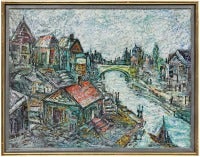Charles Melohs
Mixed Media Composition "Desert Rider, " by Charles Melohs, circa 1956
Located in Los Angeles, CA
Charles Melohs (American, 1908 – 1982)
Desert Rider, circa 1956
Mixed media composition on canvas
Category
Vintage 1950s American Expressionist Paintings
Materials
Canvas
$4,500
H 37 in W 29 in D 1.25 in
Recent Sales
UNTITLED (ABSTRACT CITYSCAPE)
By Charles Melohs
Located in Los Angeles, CA
Subject: Cityscape, Village, Bridge
Dimensions: 30 1/2" x 38 1/4" x 1 1/2"
Category
20th Century Landscape Paintings
Materials
Oil, Canvas
Get Updated with New Arrivals
Save "Charles Melohs", and we’ll notify you when there are new listings in this category.
More Ways To Browse
White Heat Poster
Willy Guhl Cauldron
Willy Guhl Modular Cubes
Wood Tissue Holder
Woodard Planter
Yemen Jewelry
Yixing Zisha
Yngve Ekstrom Bar Cart
Zebra Head Sculpture
Zuid Holland Art Nouveau
18th Century Pewter Tankard
18th Century Sterling Silver Pint Mug
1930s Porcelain German Coffee Pot
19th Century Middle Eastern Arabic Coffee Pot
19th Century Spanish Olive Oil Jar
19th Century Spongeware Pitcher
20th Century Concrete Lounge Chairs
3 Stack Antique Barrister Bookcase

